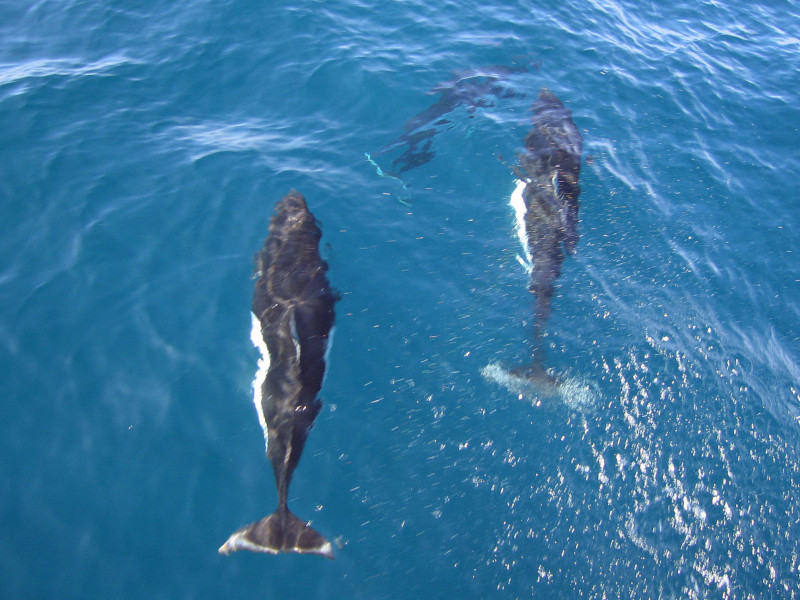
Dall’s Porpoise Facts
- Perhaps most notably, the beautiful cetacean named the Dall’s Porpoise presently constitutes the largest of all known extant porpoises. The truly marvelous creature also currently represents the only member classified in its genus of Phocoenoides.
- This gorgeous mammal also holds a somewhat unusual, though certainly not unknown, distinction. That’s because it bears its common name in honor of a specific individual. More specifically, though, it’s named after the American naturalist, W. H. Dall.
- Fortunately, its population numbers appear to be reasonably high, and also relatively stable. That holds true throughout its range. The IUCN, therefore, lists this particular marine mammal as a Species of Least Concern on its Red List of Threatened Species.
- This amazing porpoise further enjoys the status of a protected species within a certain portion of its natural range. Unfortunately, however, the amazing Dall’s Porpoise does not enjoy similar protection throughout the entirety of its endemic territorial range.
- That’s because it remains a commercially fished species in the country of Japan, in Asia. For the moment, the government of the country allows a quota of 17,000 individuals to be taken each year. Sadly, the animal also now faces other threats to its existence.
- For one, environmental contaminants now pollute parts of its range, including such compounds as PCB’s. It also now faces newly expanding perils. Much like other species, it finds itself threatened by the ongoing and escalating effects of climate change.
Related Articles
Vaquita
Dall’s Porpoise Physical Description
Although the beautiful Dall’s Porpoise indeed qualifies as the largest of all known porpoises, it also stands out from its brethren for other reasons, as well. This holds especially true of others of its own kind presently sharing the same approximate native territorial range.
The beautiful mammal does have the trait of sexual dimorphism in common with them, though. In the case of this particular animal that trait mainly displays itself in terms of sheer physical size. That characteristic trend holds true of countless species, though.
But this wonder of Nature and evolution doesn’t simply stop there. The species also displays the characteristic in the development of some slight variations in its basic form, as well. Thus, the physical trait presents in terms of both simple size and body shape.
Males of the Dall’s Porpoise typically attain a larger body size. This gender reaches a maximum body length of roughly 7.87 ft (2.4 m). Weights vary between individuals of both genders. This weight commonly ranges between a total of 370 – 490 lb (167.8 – 222 kg).
The male members of this intriguing species also possess a deeper caudal fin and an angled dorsal fin. Female examples of the animal, however, develop as slightly smaller in physical size, and with the different fins. This further mimics most other known porpoises.
But, both genders of the remarkable creature display the characteristic of color combinations varying widely among individuals of both genders. This, though, typically consists of being mainly black, with gray or white patches on the stomach and flank.
- Kingdom: Animalia
- Phylum: Chordata
- Class: Mammalia
- Order: Artiodactyla
- Family: Phocoenidae
- Genus: Phocoenoides
- Species: P. dalli
Dall’s Porpoise Distribution, Habitat, and Ecology
The mesmerizing cetacean known as the Dall’s Porpoise possesses a natural range that consists of the region of the North Pacific. More precisely, this range extends from the Sea of Japan to the coast of California, in the United States, and to the Bering Sea.
Scattered individuals sometimes appear as far south as lagoons in Baja California, in Mexico, however. Wherever it appears, though, it displays strong environmental preferences. Predominantly, this fascinating species of cetacean prefers to inhabit colder waters.
This usually includes waters with a temperature measuring less than 64 F (18 C). The creature also most commonly appears in offshore waters, at great depths. Some individuals do occasionally frequent deeper coastal waters, including fjords and canyons.
The Dall’s Porpoise feeds principally as an opportunistic hunter, much like many elated species. It additionally generally hunts its prey either near the surface or in mid-range depths. That prey further most commonly consists of a wide range of small fish species.
Small squids and even crustaceans are also consumed. These comprise only a small portion of the diet, though. This animal also appears to be a highly active creature. It’s further capable of reaching and maintaining great speeds, up to as much as 34 mph (55 kph).
Most commonly, this amazing animal lives in small social groups. These typically average between 2 – 20 individuals. But, large groups of as many as 100 individuals do sometimes occur, though usually for group hunting. Life expectancy appears to be 15 – 20 years.
Species Sharing Its Range
Check out our other articles on 5 Fabulous European Mammals, Long Eared Owl, Ebor Falls, Victoria amazonica, Hawksbill Sea Turtle, Eastern Tent Caterpillar, Visayan Spotted Deer
